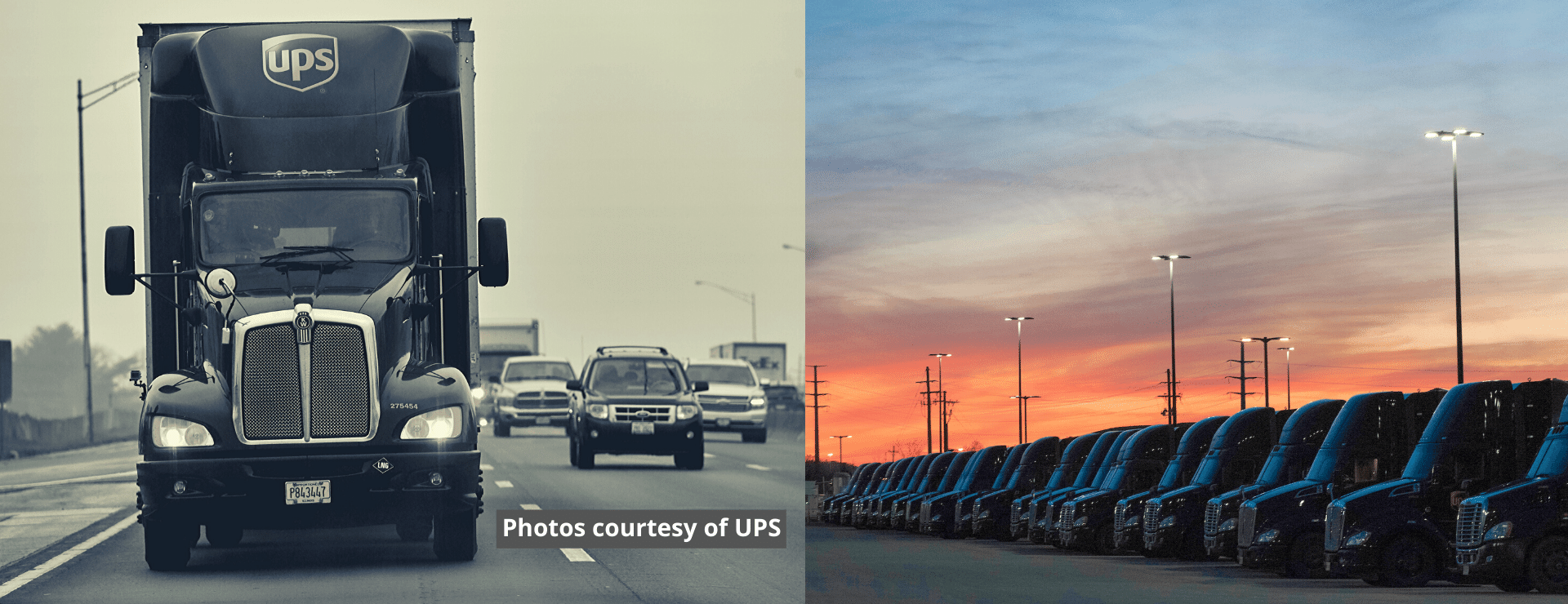AMERICANS FOR TRANSPORTATION MOBILITY COALITION (ATM)
Originally posted in FasterBetterSafer
Part One of a Two-Part Series
When Americans celebrated the holidays, many of their homes and businesses were filled with gifts, paper goods, food and gadgets delivered by an extensive UPS fleet negotiating the nation’s weathered transportation network.
During the 2019 peak holiday season, which ran from Nov. 29 to Dec. 30, the company was projected to deliver an average of 32 million packages and documents a day — a 60 percent increase over what it delivers on an average, non-peak day. This equals nearly three quarters of a billion holiday presents, medical supplies, auto parts, computer equipment and legal documents in one month.
To handle the holidays, the company added seasonal positions, among other efforts. It also has new highly automated super-hubs and new large aircraft, and deploys proprietary systems that include tools to help avoid bottlenecks.
Technology, online shopping, and shipping competitors such as UPS, FedEx and Amazon are recasting how, and how quickly, goods move today.
 Mike Marshall has worked for UPS for nearly two decades. As the Transportation Manager for the company’s Minnesota & Wisconsin territory, he oversees dozens of facilities and hubs cumulatively, dispatchers, a management team of about 60 people, and nearly 700 tractor-trailer drivers who know Minnesota and Wisconsin’s infrastructure problems well. At UPS, these drivers are known as feeder drivers and not by the American colloquialism of trucker, as they “feed” the UPS network with trailer-loads of packages.
Mike Marshall has worked for UPS for nearly two decades. As the Transportation Manager for the company’s Minnesota & Wisconsin territory, he oversees dozens of facilities and hubs cumulatively, dispatchers, a management team of about 60 people, and nearly 700 tractor-trailer drivers who know Minnesota and Wisconsin’s infrastructure problems well. At UPS, these drivers are known as feeder drivers and not by the American colloquialism of trucker, as they “feed” the UPS network with trailer-loads of packages.
Globally, and in every city and nearly every nook and cranny of the United States, UPS moves packages. They generally originate as bulk freight, internationally or domestically, and are shipped by air, water, rail and roads. For UPS, its U.S. feeder operations are a major and indispensable link to getting packages to homes and businesses in the company’s iconic brown package delivery vehicles.
“Really, the majority of work at UPS is about what’s happening behind the scenes, and that is moving those packages in the transportation network across the country,” Marshall says. “It’s really a hub-and-spoke-type situation where regionally there are a number of hubs around the country and smaller buildings that feed all those hubs.
“In Minnesota, we have 24 smaller buildings that each have their own drivers of tractor trailers and they’ll bring volume from those smaller centers into a larger hub — for example, into Minneapolis or St. Paul — and that volume will be processed, unloaded from trailers, and loaded back into new trailers and then sent back out to further destinations. And so we’re talking about, on any given night in one of those hubs, hundreds of thousands of packages being processed and sent out in trailers.”
UPS’s network is tight to reduce the time goods are in transit, according to Marshall. The more that feeder drivers sit on the road, the longer it can take for packages to get to their final destinations, and the more wear and tear this puts on roads and bridges. There is also a labor-sector component because drivers are unionized and annually bid on routes based on seniority.
For Marshall’s region, what follows is just a fragment of what the experts say about regional infrastructure challenges: In the Minnesota 2018 Infrastructure Report Card, the Minnesota Section of the American Society of Civil Engineers (ASCE) gave Minnesota’s roads a grade of D+, noting that state roads are underfunded by $17.7 billion over the next 20 years. A September 2018 report, “Wisconsin Transportation by the Numbers,” by the national transportation research group TRIP, concluded that “half of major locally and state-maintained roads and highways in Wisconsin are in poor or mediocre condition” and “more than 2,800 people were killed in traffic crashes in Wisconsin in the last five years.”
Roads, bridges, rail, airports and ports are among the anchors of our nation and economy. Without each properly maintained, modernized and invested in, our transportation system is slower, less safe and not as efficient.
Infrastructure was a prominent issue in the 2016 presidential election and it polls high among Americans, but neither the White House or Congress has passed new infrastructure investment legislation. Also, neither has addressed the depleting Highway Trust Fund (funded from a tax on motor fuels last increased in 1993) or prioritized a comprehensive blueprint to determine how America’s infrastructure will be paid for, expanded and updated.
Especially for businesses hauling goods, mobility and the longevity of infrastructure are climacteric issues. The drivers Marshall supervises are moving trailers (known as UPS sets, which are two small trailers coupled together) that weigh upwards of 80,000 pounds, and carry about 65,000 pounds of freight.
Marshall’s drivers are encountering increased delays in main corridors and reconstruction zones (and in the era of smartphones) where accidents involving other motorists who are not paying attention are more frequent. He also observes that short-range infrastructure fixes have likely become the norm in more recent years.
“Because we’ve gotten used to the traffic increasing, we’ve had to adjust schedules and start times so these drivers are actually working longer hours than they were before to do the same amount of work,” explains Marshall. “If you look at the schedules my drivers are actually running about 45 minutes more per day due to congestion. We’ve seen the delays increase over the last few years, and it’s happening in a lot of these metro areas, where we’re talking about congestion, such as Minneapolis-St. Paul, Milwaukee and certainly down to Chicago.”
He adds, “Infrastructure absolutely is at a critical point in America because the concern has always been with a lot of these construction projects, ‘Are we building and reconstructing these areas to handle what’s happening now or are we having the foresight to take a look at what’s going to be happening tomorrow and years down the road?’ The concern I have for officials is, yes, you are redoing the road but are you really enhancing lanes, are you widening lanes, are you adding lanes?’ That’s what I see that is not happening as much as I would have hoped. It’s a lot of, the road’s not in good condition so let’s redo the part of the road that’s already there.”
Marshall’s group of drivers have next-generation handheld devices that provide information, schedules (including changes that may come up), messaging and alert systems to facilitate efficient communications and work days.
But there are growing variables beyond the company’s control that have to be addressed because of the amount of crashes, congestion and delays on our national highway system now. Larger populations and more freight moving, coupled with worsening infrastructure, are producing a tipping point.
Data show that the demand on the interstate system — with the increase of goods moving up and down it — is going to grow exponentially over the next several years, Marshall adds.
Information from TRIP confirms this. “The amount of freight transported in the U.S. is expected to increase significantly as a result of further economic growth, changing business and retail models, advances in manufacturing, warehousing and supply chain automation, increasing international trade, and rapidly changing consumer expectations that place an emphasis on faster deliveries,” says Rocky Moretti, Director of Policy & Research for TRIP. “Each year, the U.S. freight system moves approximately 17.7 billion tons of freight, valued at $16.8 trillion. Trucks carried 72 percent of freight by value in 2016 and 66 percent by weight.”
Marshall notes some of the route constants now: old narrow roads in outlying (called extended) areas that in wintry weather make conditions dangerous; Wisconsin areas where even slight rain events lead to flooding and delays; crashes and ongoing reconstruction in main corridors and on highway systems, with the latter resulting in unprecedented and significant delays from Milwaukee to Chicago.
He says chokepoints on I-94, specifically in the region that runs from the south side of Milwaukee at Oak Creek up to the north side and past the Milwaukee Mitchell International Airport (MKE), have led to heavy gridlock in the past seven years. Marshall mentions, too, that the Zoo Interchange freeway project, underway for years, didn’t remedy daily congestion.
Thus, infrastructure shortcomings in America require UPS, in the short-term, to rearrange drivers, schedules, pickups and routes at critical moments every day. In the long-term, it prioritizes having good relationships with its customers, continually examining and improving its supply chain to address how to move goods safely and quickly.
To address the speed at which commerce and interfacing now happen and shipped goods get to customers, for instance, UPS is planning on expanding its longer-haul sleeper-driver network through which members of a tandem team split time driving and sleeping, so freight can get to California, from Minnesota and Wisconsin, in a day and a half, instead of the four days it takes via rail. However, this will put more strain on roads and bridges.
Marshall wonders about the investment D.C. is making in infrastructure and in the Midwest. “Think about what you’re losing on the back end by not investing early on the front end,“ he says. “Are we building out enough for what this country is going to need down the road?”
Sign the petition to tell our leaders to rebuild America here: https://action.uschamber.com/yYv5aKO
View original post on FasterBetterSafer
About the Americans for Transportation Mobility Coalition (ATM)
www.fasterbettersafer.org
The Americans for Transportation Mobility (ATM) Coalition formed in 2001. It brings together businesses, the labor and union sectors, transportation stakeholders, and the public to advocate a robust transportation infrastructure grid in the United States. This includes promoting ongoing and sustainable funding through policies and broad-based initiatives.







 RSS Feed
RSS Feed